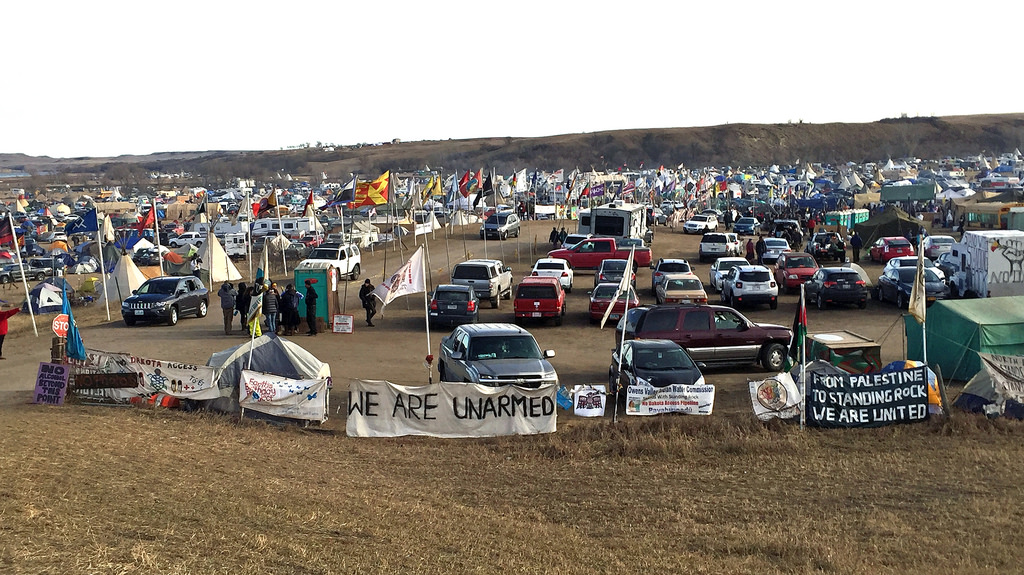Only Nonviolent Resistance Will Destroy Corporate State
Standing Rock and 20th century history offer crucial guidance: A movement’s success depends on organization, discipline and not being baited into violence. The Oceti Sakowin camp, near the Standing Rock reservation in North Dakota, in November 2016. (Becker1999 / Flickr)
The Oceti Sakowin camp, near the Standing Rock reservation in North Dakota, in November 2016. (Becker1999 / Flickr)
The encampments by Native Americans at Standing Rock, N.D., from April 2016 to February 2017 to block construction of the Dakota Access pipeline provided the template for future resistance movements. The action was nonviolent. It was sustained. It was highly organized. It was grounded in spiritual, intellectual and communal traditions. And it lit the conscience of the nation.
Native American communities—more than 200 were represented at the Standing Rock encampments, which at times contained up to 10,000 people—called themselves “water protectors.” Day after day, week after week, month after month, the demonstrators endured assaults carried out with armored personnel carriers, rubber bullets, stun guns, tear gas, cannons that shot water laced with chemicals, and sound cannons that can cause permanent hearing loss. Drones hovered overhead. Attack dogs were unleashed on the crowds. Hundreds were arrested, roughed up and held in dank, overcrowded cells. Many were charged with felonies. The press, or at least the press that attempted to report honestly, was harassed and censored, and often reporters were detained or arrested. And mixed in with the water protectors was a small army of infiltrators, spies and agents provocateurs, who often initiated vandalism and rock throwing at law enforcement and singled out anti-pipeline leaders for arrest.
The Democratic administration of Barack Obama did not oppose the pipeline until after the election of Donald Trump, who approved the project in January 2017 soon after he became president. The water protectors failed in their ultimate aim to stop the construction, but if one looks at their stand as a single battle in a long war, Standing Rock was vitally important because it showed us how to resist.
In November of last year I spoke with Kandi Mossett, one of the water protector leaders, when I visited the North Dakota encampments. We were standing over one of the sacred fires.
“He starts throwing rocks at police,” she said of an infiltrator who shadowed her and pointed her out to law enforcement for arrest. “When he throws rocks I see a few other people throw water bottles. One of our women says, ‘Stop throwing shit!’ So people stop. But there’s instigators and infiltrators. We’ve had, here at this fire, two women who were called bikers because of the way they were dressed. When they lifted up their hands with everybody, people saw they had wires on. [Water protector] security went to them. They said, ‘We see that you’re miked.’ They took off running. Went over the fence. And a car came zooming, picked them up, and they took off. It’s not easy to keep [infiltrators] out. They can roll under the fence. They can come from under the security gates. We know they’re here.”
The corporate state, no longer able to peddle a credible ideology, is becoming more overtly totalitarian. It will increasingly silence dissidents out of fear that the truth they speak will spark a contagion. It will, as in China’s system of totalitarian capitalism, use the tools of censorship, blacklisting, infiltration, blackmailing, bribery, public defamation, prison sentences on trumped-up charges and violence. The more discredited the state becomes, the more it will communicate in the language of force.
“This world is heading towards economic systems that continue to eat up life itself, even the heart of workers, and it’s not sustainable,” Native American and environmental leader Tom B.K. Goldtooth told me when we spoke at one of the camps last year. “We’re at that point where Mother Earth is crying out for a revolution. Mother Earth is crying out for a new direction.”
“As far as a new regime, we’ll need something based on earth jurisprudence,” he said. “A new system away from property rights, away from privatization, away from financialization of nature, away from control over our … DNA, away from control over seeds, away from corporations. It’s a common law with local sovereignty. That’s why it’s important we have a system that recognizes the rights of a healthy and clean water system, ecosystem. Mother Earth has rights. We need a system that will recognize that. Mother Earth is not an object. We have an economic system that treats Mother Earth as if she’s a liquidation issue. We have to change that. That’s not sustainable.”
“If the pipeline is built, is that a defeat?” I asked him. He replied wryly, “That oil is going to run dry a lot sooner than they think. Maybe that corporation is going to go bankrupt. Who knows?”
“I talk about the need for young people to have patience, to put the prayer first, rather than just jumping out there and putting their energy into action,” he said. Angry reaction is “what the corporations want. That’s what the government wants. They want us to react. They want us to feel that anger. When the anger escalates, our feelings, frustrations, it goes back to that rage. The rage of the machines. It’s also unhappy. It feeds off the unhappiness of people.”
George Lakey, the Eugene M. Lang Visiting Professor for Issues in Social Change emeritus at Swarthmore College and a sociologist who focuses on nonviolent social change, talked about Sweden and Norway’s response in the 1920 and ’30s to the rise of fascism and compared it with the response in Italy and Germany. We live in a historical moment similar to when fascism was ascendant between the two world wars, he argues. Lakey was a trainer during the civil rights movement for Mississippi Freedom Summer and co-authored “A Manual for Direct Action: Strategy and Tactics for Civil Rights and All Other Nonviolent Protest Movements,” one of the seminal texts of the civil rights movement.
“Fascism was a definite threat,” he said of the situation faced by Sweden and Norway. “And they were also experiencing [economic] depression. Norway’s degree of depression was even worse than Germany’s. It was the worst in Europe. The highest unemployment in Europe. People were literally starving. The pressure, the pro-fascist setup that the depression brings, was very present both in Sweden and in Norway. What the Nazis did there—what they did in Germany and what the fascists did in Italy—was provocation, provocation, provocation. ‘Bait the left. The left will come. And we’ll have street fighting.’ ”
Street violence, he said in echoing Native American elders, always “strengthens the state.”
“It puts more pressure on the state—which is presided over by the 1 percent—to step in more and more forcefully, with the middle class saying, ‘We care about order. We don’t want chaos,’ ” he said. “That’s what happened in Germany. It was a strengthening of the state. This happened in Italy as well. That’s what the game plan was for fascists in Norway and Sweden. It didn’t work. It didn’t work because the left didn’t play their game. They didn’t allow themselves to be baited into paying attention to them, doing street fighting.”
“Instead, [what was done] in the civil rights movement we would have called ‘they kept their eyes on the prize,’ ” Lakey said. “They knew the prize was to push away the economic elite, get rid of its dominance, so they can set up a new economic system, which is now called the Nordic model. What they did was: massive strikes, massive boycotts, massive demonstrations. Not only in the urban areas, which is what you expect, but also in the rural areas. During the Depression [in Sweden and Norway], there were lots of farmers who had their farms foreclosed on. Farmers are perennially in debt and had no way of repaying that debt. When the sheriff came, farmers in that county would come to join them and collectively not cooperate—not violently, but very strongly—in such a way that the sheriff couldn’t carry out the auction.”
“Remember who is actually running things, and we keep our focus on them both politically and economically,” Lakey said.
“The group I’m involved with [Earth Quaker Action Team] loves to go after corporations,” he said. “We went after a bank [PNC], the seventh largest bank in the country but it was the No. 1 financier of mountaintop-removal coal mining in Appalachia. We forced that bank out of [the] business of financing mountaintop coal mining. Nonviolently. Disrupting. Disrupting. We were in bank branches all over the place. We shut down two shareholder meetings. We led a boycott in which people took out money from that bank and were putting it in their local credit unions. So there’s more than one way to go after the 1 percent.”
“These days, a very smart way to do that is to focus on the economic entities that are owned by the 1 percent, who are basically responsible for the oppression that we experience,” he said.
Resistance, he stressed, will come from outside the formal political system. It will not be embraced by either of the two main political parties or the establishment, which is now under corporate control.
“The Democratic Party is out to lunch,” he said. “The Republican Party is actively grinding us. But even so we can make tremendous strides and start building that mass movement, which in Norway and Sweden was able to push the economic elites away. So that’s an indication of the way to build a movement—which is not to take them on the way antifa suggests. Instead, in the way the civil rights movement did. It worked. I was there. The Ku Klux Klan was much stronger then than it is now. In the Deep South, the Ku Klux Klan virtually ran the [region].”
Resistance, he said, means movements have to keep “pushing, pushing, pushing. Campaign after campaign after campaign.” It must always stay “on the offensive. That’s the secret.”
“As soon as they lost that sense of going on the offensive, choosing campaign after campaign and winning those campaigns, that was when they lost their momentum,” he said of the civil rights movement. “The important thing about what happened in Norway and Sweden was they kept their momentum. The campaigns continued to grow in number and in power until the economic elite was out.”
“I was very influenced by Bayard Rustin, who was the chief strategist for Dr. [Martin Luther] King,” he said. “I heard Bayard say over and over and over, ‘If we don’t get this economic justice thing done, in 50 years we’re still going to have rampant racism.’ He was right. But Dr. King and the other leaders who understood that were not able to get a sufficient number of people to make it. Now, the ’63 march was for jobs and justice. So they were able to do it to some degree. They kept moving in that direction, involving white trade unions in that process. But in the situation of general prosperity, there were many people who were content with our economic system.”
Economic decline, deindustrialization, austerity, debt peonage, decay and collapse of social services and infrastructure and the impoverishment of the working class, Lakey said, have changed the configuration. The working class, in short, can no longer be bought off.
“We’re in a very different situation,” he said. “We’re still in austerity. There’s not the degree of [contentment] that there once was. Trump has obviously capitalized on that fact. There’s discontent. I think what Dr. King and Bayard and others wanted to happen in the ’60s is now realizable.”
“The impact of ignoring climate change is going to be more and more disastrous,” he added. “We’re just through it now with [a devastating hurricane in] Houston. We’re going to see more and more money drained off by that [kind of natural disaster]. Again, the 1 percent won’t want to pay their fair share. What that leaves us is a population that is more and more discontent. We see that polarization going on. Polarization always goes along with increased inequality. We can expect more polarization. That’s a part of the temptation of antifa: ‘I’m more and more upset.’ ”
“When dealing with mountaintop-removal coal mining, we went from an organization [Earth Quaker Action Team] that started in a living room to 13 states,” he said. “We were steadfastly nonviolent. And we were targeting something people understood. ‘Wow, you’re going after the bank that’s financing this? I want to join that.’ Even though there were some people who were like, ‘We’d like a little more politeness, please.’ They didn’t get it because what we were about was making the bank’s life so difficult that they would choose instead to get out of the business [of mountaintop mining].”
Lakey cautioned against diverting energy to attacking neo-Nazi and white supremacist groups. That, he said, is a gift to the state.
“There’s really no need for us to shift our attention from going after the 1 percent to go after, often, working-class guys on the extreme right,” he said. “For one thing, we look at their real, genuine grievances and address them. For example, how many people on the right are from working-class families who have family members who are not being served by our health care system? Many people on the far right are from a demographic that is actually losing life expectancy for the first time in U.S. history. The health care system in the U.S is a mess. Obamacare is better than previous, but it’s a mess. So what we can do is address the genuine grievances instead of writing people off as if obsession with racism is all that’s going on. Fascism grows when the economy declines. So let’s address the real thing instead of the symptom.”
While refusing to be baited into violent confrontations with the radical right, we must also be vigorous in using militant, nonviolent tactics to block hate speech. Article 4 of the International Covenant on the Elimination of All Forms of Racial Discrimination, adopted by the United Nations in 1965, stipulates that “all propaganda and all organizations” based on ideas or theories of racial or ethnic superiority should be illegal. It urges states to take positive steps to eliminate them.
Dr. Margaret Flowers and Kevin Zeese of Popular Resistance dealt with the issue of hate speech recently when a Baltimore chapter of the League of Women Voters held a series of panel discussions on immigration. The chapter invited speakers from anti-immigrant white supremacist groups listed as hate groups by the Southern Poverty Law Center. Despite public outcry, the league refused to withdraw the invitations. At the initial event the speaker was prevented from completing his presentation by anti-racist activists and members of the local chapter of the Green Party.
“Organizations and institutions do not have a requirement to include those who espouse hate,” Flowers and Zeese wrote of the event. “They are not required to give a platform to or legitimize white supremacist views. In fact, one could argue that it is anti-social to do so.”
“We would do better as a society to debate the best ways to eliminate white supremacy,” they added.
Lakey’s prescription: “Consistently occupy the moral high ground, and that attracts support.” “It defangs those who want to do us in,” he said. “It’s not like the 1 percent was fond of the civil rights movement. They had to be dragged kicking and screaming into making concessions. J. Edgar Hoover was even quoted as saying, ‘He’s [King] the most dangerous man in America.’ ”
And, Lakey said, “there’s a psychological reward. Going for what you want, instead of opposing what you don’t want, is itself fulfilling. It was civil rights. It was called the Freedom Movement. It’s also called a black liberation movement. It was all about positivity.”
To see Chris Hedges interview professor George Lakey, click here.
Your support matters…Independent journalism is under threat and overshadowed by heavily funded mainstream media.
You can help level the playing field. Become a member.
Your tax-deductible contribution keeps us digging beneath the headlines to give you thought-provoking, investigative reporting and analysis that unearths what's really happening- without compromise.
Give today to support our courageous, independent journalists.






You need to be a supporter to comment.
There are currently no responses to this article.
Be the first to respond.